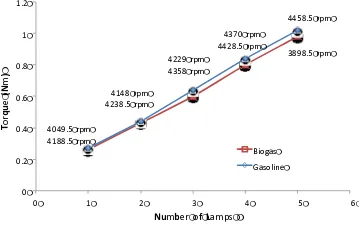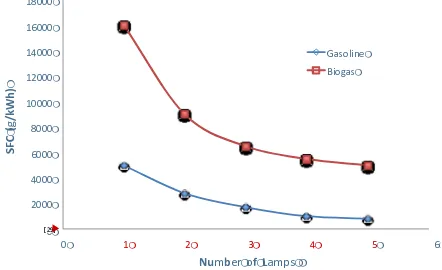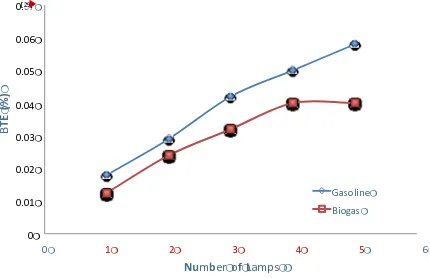All sources 611 Internet sources 47
1 documents with identical matches
[18]
wtlab.iis.u-tokyo.ac.jp/~wataru/publication/pdf/siberian_railway.pdf
3
3.6% 10 matches
1 documents with identical matches
[40]
iopscience.iop.org/article/10.1088/1755-1315/16/1/012026/pdf
0
0.6% 1 matches
1 documents with identical matches
[42] https://www.researchgate.net/publication...olvent_precipitation
Sensitivity: High
Bibliography: Bibliography excluded
Citation detection: No detection
--This content has been downloaded from IOPscience. Please scroll down to see the full text.
[11] [11]
Download details:
IP Address: 114.125.29.[11]5
This content was downloaded on 04/07/2017 at 16:32[11]
Please note that terms and conditions apply.
Performance Evaluation on Otto Engine Generator Using Gasoline and Biogas from Palm Oil
[14]
Mill Effluent
View the table of contents for this issue, or go to the journal homepage for more 2017 IOP Conf. Ser.: Mater. Sci. Eng. 206 012028
(http://iopscience.iop.[11]org/1757-899X/206/1/012028)
Home Search Collections Journals About Contact us My IOPscience
You may also be interested in:
Effect of Agitation on Acidogenesis Stage of Two-Stage Anaerobic Digestion of Palm Oil Mill
[28]
Effluent (POME) into Biogas B Trisakti, Irvan, H Adipasah et al.
Effect of Recycle Sludge on Anaerobic Digestion of Palm Oil Mill Effluent in A Thermophilic
[5]
Continuous Digester
Irvan, B Trisakti, Y Tomiuchi et al.
Preliminary experimental results of Sewage Sludge (SS) Co-digestion with Palm Oil Mill Effluent
[28]
(POME) for Enhanced Biogas Production in Laboratory Scale Anaerobic Digester R Sivasankari, P Kumaran, Saifuddin Normanbhay et al.
Effect of temperature on methanogenesis stage of two-stage anaerobic digestion of palm oil mill
[10]
effluent (POME) into biogas
B Trisakti, Mahdalena Irvan, Taslim et al.
Performance and Emissions of a Small Compression Ignition Engine Run on Dual-fuel Mode (Diesel-Raw biogas)
H Ambarita, E P Sinulingga, M KM Nasution et al.
Performance evaluation of integrated solid-liquid wastes treatment technology in palm oil industry
[24]
J R Amelia, S Suprihatin, N S Indrasti et al.
Use of Oil Palm Waste as a Renewable Energy Source and Its Impact on Reduction of Air Pollution in
[26]
Context of Malaysia
1
[5]
Content from this work may be used under the terms of the Creative Commons Attribution 3.0 licence.Any further distribution of this work must maintain attribution to the author(s) and the title of the work, journal citation and DOI.
Published under licence by IOP Publishing Ltd
[33]
1234567890
29th Symposium of Malaysian Chemical Engineers (SOMChE) 2016 IOP Publishing IOP Conf. Series: [33]Materials Science and Engineering 206 (2017) 012028 doi:10.[51088/1757-899X/206/1] /012028
Performance Evaluation on Otto Engine Generator Using
Gasoline and Biogas from
Palm Oil Mill Effluent
Irvan1,3*, B Trisakti1,3, T Husaini1,3, A Sitio2,3 and TB Sitorus2,3
1
Chemical Engineering Department, University of Sumatera Utara, Medan, 20155, Indonesia
2
Mechanical Engineering Department, University of Sumatera Utara, Medan, 20155, Indonesia
3
Sustainable Energy and Biomaterial Center of Excellence, University of Sumatera Utara, Medan, 20155, Indonesia
E-mail: *[5][email protected]
Abstract.[10] Biogas is a flammable gas produced from the fermentation of organic materials by
anaerobic bacteria originating from household waste manure and organic waste including palm
oil mill effluent (POME). POME is mainly discharged from the sterilization unit [30] of palm oil processing into crude palm oil. This study utilized biogas produced from liquid waste palm oil for use as fuel in the Otto engine generator 4 stroke, type STARKE GFH1900LX with a peak – power of 1.3 kW, 1.0 kW average power, bore 55 mm, stroke 40 mm, Vd 95 × 10-6 m3, Vc 10 ×
10-6 m3, compression ratio of 10.5 :[43] 1 , and the number of cylinders = 1. The objective [28] of this study is to evaluate the performance of Otto engine generator fueled with biogas that generated from POME, then comparing its performance fueled by gasoline. The performance included power, torque, specific fuel consumption, thermal efficiency, and the air-fuel ratio. Experiment was conducted by using a variation of the lamp load of 100, 200, 300, 400, and 500 W. The results revealed that the use of biogas as fuel decreased in power, torque, brake thermal efficiency, and air fuel ratio (AFR), while there is an increasing of value specific fuel consumption (SFC).
1. Introduction
Fossil fuels mentioned as the most important energy sources in the world are depleting day by day. In addition, environmental issues have become dilemma due to more fossil fuel are used. Many
researchers especially in Indonesia have developed alternative fuel in order to overcome the above problems such as biogas, bioethanol, biodiesel etc. Biogas is a clean and renewable resource that can be used as fuel or other purposes.[44]It discharges less harmfully pollutant to the atmosphere than the
burning of fossil fuel[44]. The main constituents in biogas are methane (CH4), carbon dioxide (CO2), and
hydrogen sulfide (H2S) [1].
Biogas can be produced using a wide range of feedstock include municipal wastewater, diary manure, food processing wastewater and agricultural waste [2].[30] Indonesia as tropical country has
numerous biogas resources generated from agricultural production especially in palm oil industries
such empty fruit bunches, fibre, shell and palm oil mill effluent (POME).
POME, which is brownish, viscous and acidic liquid waste (pH ranges between 4 and 5), cannot be
[29]
2
1234567890
29th Symposium of Malaysian Chemical Engineers (SOMChE) 2016 IOP Publishing IOP Conf. Series: Materials Science and Engineering 206 (2017) 012028 doi:10.1088/1757-899X/206/1/012028
30,000 and 25,000 mg/l, respectively and generally was discharged at high temperature (80-90°C) [3, 4, 5].[5] Table 1 summarizes the properties of palm oil mill effluent [6].
Table 1. Properties of fresh palm oil mill effluent
Parameters* Values
pH 4 5 –
Total Solid (TS) 40,500 72,000 –
Volatile Solid (VS) 34,000 49,300 –
COD 44,300 102,000 –
BOD 25,000 65,714 –
Kj-N 560 1,200 –
Fat 1,700 9,200 –
* Unit for all parameter is mg/L except pH
Typically, 1 ton of fresh palm oil fruit bunch (FFB) generates approximately 0.1 ton or 0.65 m3 of POME [7]. Thus, there is a great potential for POME to be utilized as the fuel to produce renewable energy. Moreover, besides reducing pollutant, a by-product from the production of biogas, can be used as liquid fertilizer and pesticide.
Some researchers have performed various tests in order to study the performance of engine fueled
[10]
by biogas [8, 9, 10, 11]. They focused mainly on some parameters such as: compression ratio, the torque and power. The results of their study lead to the conclusion that biogas fueled engines have a good prospect in future.[34]
Irvan et al in 2016 conducted POME conversion into biogas at laboratory scale and pilot scale using
anaerobic microbes at temperature 55oC (thermophilic) [12]. This research aimed to utilize biogas
produced from pilot scale as fuel for Otto engine generator. Then the performance included power, torque, specific fuel consumption, thermal efficiency, the air-fuel ratio, exhaust emissions and combustion in spark plugs were evaluated and then comparing it using gasoline.
2.[43]Materials and Methods
2.1. Production of Biogas
Biogas was obtained by anaerobic fermentation of POME in the digester at working volume of 3.7 m3[15]. Schematic drawing of pilot plant is shown in figure 1.
Fresh POME was filled into the continuous stirred feed tank, here POME was heated up to 70oC.
Hot POME was then fed to the mixing tank by a centrifugal pump every two hours. The amount of daily feeding POME became 616 liters per day.[5]Hydraulic retention time (HRT) of digester was
maintained at 6 days. Hot POME and return sludge were mixed in the mixing tank for approximately
five hours and still maintained at 70oC. Then this mixed waste was pumped by screw pump into an
3
1234567890
29th Symposium of Malaysian Chemical Engineers (SOMChE) 2016 IOP Publishing IOP Conf. Series: Materials Science and Engineering 206 (2017) 012028 doi:10.1088/1757-899X/206/1/012028[34]
of H2S and CO2 in the biogas were measured by using a suction gas injector (GASTEC, type
GV-100S) and inspection tube (GASTEC, 25 ~ 1600 ppm). Characteristics of biogas produced from the pilot plant are presented in Table 2.
Figure 1. Schematic drawing of pilot plant
Table 2. Characteristics of biogas from the pilot plant
Parameter Unit Values
Gas generation NL/gr VS* 0.68
Methane % 60
CO2 % 30
H2S ppm 40
2.2. Otto Engine Generator Fed with Biogas
The engine used in this study was 4 stroke, type STARKE GFH1900LX with a peak power of 1.3 –
kW, 1.0 kW average power, bore 55 mm, stroke 40 mm, Vd 95 × 10-6 m3, Vc 10 × 10-6 m3,
compression ratio of 10.5 : 1, and the number of cylinders = 1. Although, the objective of this work is to determine the performance of the Otto engine fed with biogas, it also used gasoline as a reference parameter.
Engine performance tests were conducted by varying the electrical power above 100 kW. When the electrical power was given then the electrical voltage and current were measured by using a multimeter.[12] Meanwhile, a tachometer was used to determine the rotation number of the engine. By [43] using gasoline, performance test was carried out for 5 minutes each load variation, then amount of fuel mass reduced in the tank were measured. Using biogas, performance test was performed by flowing it from the 100 L storage tank at 6 bar to the modified carburetor.[43] The engine was turned on until the
4
1234567890
29th Symposium of Malaysian Chemical Engineers (SOMChE) 2016 IOP Publishing IOP Conf. Series: Materials Science and Engineering 206 (2017) 012028 doi:10.[51088/1757-899X/206/1] /012028
3. Results And Discussions
3.1. Engine power
Experiments in order to know performance test of the engine by using gasoline and biogas were conducted by varying the number of lamps used. Figure 2 shows the engine power curves by using gasoline and biogas.
Figure 2. The engine power curves by using gasoline and biogas
By using gasoline, if number of lamps were added then rotation and power increased. A load of 1 lamp, the engine generated rotation by 4049.5 rpm with output power of 114.1 Watt, and the load of 5 lamps, rotation and power were 4458.5 rpm and 517.6 Watt respectively. Biogas used as fuel with one lamp, the engine generated a power of 107.25 Watt at 4188.5 rpm engine speed, and the load of 5 lamps were 424.7 Watt at 4398.0 rpm.
The decreasing of rotation number and output power were caused by the CO2 content in the biogas
which reaches 30 %. It affected to the combustion of biogas inside the engine which became slower and the heat value of biogas became lower. At last, biogas were accumulated inside the heat chamber, caused combustion process became inefficiency. This was indicated by the decreasing of rotation, followed with a drop in generated power generator engine.
3.2. Torque
Similar to engine power, using gasoline, if number of lamps were added then the greater the torque produced. A load of 1 lamp, the engine produced 0.269 Nm torque at 4049.5 rpm, and the load of 5
lamps, 1.019 Nm torque was obtained at 4458.5 rpm. Figure 3 shows the torque curves by using gasoline and biogas.
Figure 3.[12] The torque curves by using gasoline and biogas
5
1234567890
29th Symposium of Malaysian Chemical Engineers (SOMChE) 2016 IOP Publishing IOP Conf. Series: Materials Science and Engineering 206 (2017) 012028 doi:10.1088/1757-899X/206/1/012028
From Figure 3 we can see that the torque generated by engine using biogas, load of 1 lamp up to 4 lamps are not so much different, but when the generators were loaded with 5 lamps, the torque was lower than the gasoline engine. The decreasing of torques was caused by engine rotation which also decreased.
3.3. Specific Fuel Consumption
Engine performance may be described in several ways, one of the useful parameters is specific fuel
consumption (SFC). It is defined as the weight of the fuel burned per unit time, per unit thrust. Generally, if the electrical load is increased then SFC value becomes smaller. Figure 4 shows the SFC curves by using gasoline and biogas. As shown on figure 4, engine with biogas has SFC value greater than the engine with gasoline. This is because the rate of fuel of biogas is greater than the gasoline.
The greatest value of SFC, indicated by engine with biogas at the load of 1 lamp generating power about 107.25 Watt at 4188.5 rpm, was around 16037.30 g/kWh. While, the lowest value of SFC was 1437.31 g/kWh, at the load of 5 lamp generating power about 517.66 Watt at 4458.5 rpm.
Figure 4. The SFC curves by using gasoline and biogas
3.4. Brake Thermal Efficiency
Brake thermal efficiency (BTE) can be defined as the ratio of the heat equivalent of the brake output to
the heat supplied to the engine. For engine by using gasoline or biogas, if the number of lamp is increased, then the BTE value also increased. Figure 5 shows the BTE curves by using gasoline and biogas. As shown on figure 5 that gasoline engine has BTE value higher than biogas engine. This is because the fuel rate of biogas is greater than gasoline.
6
1234567890
29th Symposium of Malaysian Chemical Engineers (SOMChE) 2016 IOP Publishing
IOP Conf. Series: Materials Science and Engineering 206 (2017) 012028 doi:10.1088/1757-899X/206/1/012028
Figure 5. The BTE curves by using gasoline and biogas
Figure 5 shows the highest thermal efficiency is 5.87% by using gasoline at a load of 5 lamps with output power 517.64 at 4458.5 rpm. While, the lowest thermal efficiency was 1.31%, at a load of 1 lamp generating power about 107.25 Watt at 4188.5 rpm.
3.5.[50] Air Fuel Ratio
Air fuel ratio (AFR) is the mass ratio of air to fuel present in a combustion process such as in an
internal combustion engine. The [48] AFR is an important measure for anti-pollution and
performance-tuning reasons. In general, if the electrical load is increased then AFR value becomes smaller. Figure 6 shows the AFR curves by using gasoline and biogas. As shown on figure 6, engine with gasoline has AFR value greater than the engine with biogas.
Figure 6.[50] The AFR curves by using gasoline and biogas
Figure 6 shows the highest air fuel ratio is 18.68 by using gasoline at a load of 1 lamp with output
power 114.1 at 4049.5 rpm. While, the lowest thermal efficiency was 4.5, at a load of 5 lamps generating power about 424.74 Watt at 3898.5 rpm.
7
1234567890
29th Symposium of Malaysian Chemical Engineers (SOMChE) 2016 IOP Publishing
IOP Conf. Series: Materials Science and Engineering 206 (2017) 012028 doi:10.1088/1757-899X/206/1/012028
4. Conclusion
Otto engine generator by using biogas as fuel could generate maximum power and torque of 424.74Watt and 1.04 Nm, respectively. These power and torque are approximately 42% and 49% of the power and torque that can be generated from the same engine by using gasoline. Because of biogas fuel rate is greater than the gasoline, then specific fuel consumption of biogas become larger and brake
thermal efficiency of biogas is smaller than gasoline. In the combustion process, biogas engine required less air than gasoline engine.
Acknowledgment
[61]
This research was supported by Hibah Penelitian Unggulan Perguruan Tinggi No:
017/SP2H/LT/DRPM/II/2016, date February 17th, 2016.
References
[1] Hosseini SE and Wahid MA 2013 Feasibility study of biogas production and utilization as a source of renewable energy in Malaysia, Renew. Sustainable Energy Rev. 19 454-462
[2] Dioha IJ, Ikeme CH, Nafi'u T, Soba NI and Yusuf MBS 2013 Effect of carbon to nitrogen ratio on
biogas production, Int. Res. J. of Natural Sci. 1-101
[3] Mustapha S, Ashhuby B, Rashid M and Azni I 2003 Start-up strategy of a thermophilic upflow anaerobic filter for treating palm oil mill effluent, Process Saf. Environ. Prot. 81 262-266
[4] Najafpour GD, Zinatizadeh AAL, Mohamed AR, Hasnain MI and Nasrollahzadeh H 2006 High-rate anaerobic digestion of palm oil mill effluent in an upflow anaerobic sludge-fixed film bioreactor, Process Biochem. 41 370-379
[5] Meesap K, Boonapatcharoen N, Techkarnjanaruk S and Chaiprasert P 2012 Microbial communities and their performances in anaerobic hybrid sludge bed-fixed film reactor for treatment of palm oil mill effluent under various organic pollutant concentrations, J. Biomed. Biotechnol.2012 1-11
[6] Ji CM, Eong PP, Ti TB, Seng CE and Ling CK 2013 Biogas from palm oil mill effluent (POME): Opportunities and challenges from Malaysia's perspective,Renew. Sustainable Energy Rev. 26 717-726
[7] King LS and Yu LC 2013 A retrofitted palm oil mill effluent treatment system for tapping biogas, Eur. Int. J. Sci. Tech. 106-114 2
[8] Rossetto C, de Souza, SNM, Santo RF, de Souza J, Klaus OL 2013 Performance of an Otto cycle engine using biogas as fuel, Afr. J. Agric. Res. 8 5607-5610
[9] Huang J and Crookes RJ 1998 Assessment of simulated biogas as a fuel for the spark ignition engine, Fuel 77 1793-1801
8
1234567890
29th Symposium of Malaysian Chemical Engineers (SOMChE) 2016 IOP Publishing IOP Conf. Series: Materials Science and Engineering 206 (2017) 012028 doi:10.1088/1757-899X/206/1/012028
[11] Munoz M, Moreno F, Morea-Roy J, Ruiz J, Arauzo J 2000 Low heating value gas on spark ignition engines, Biomass Bioenergy 18 431-439



